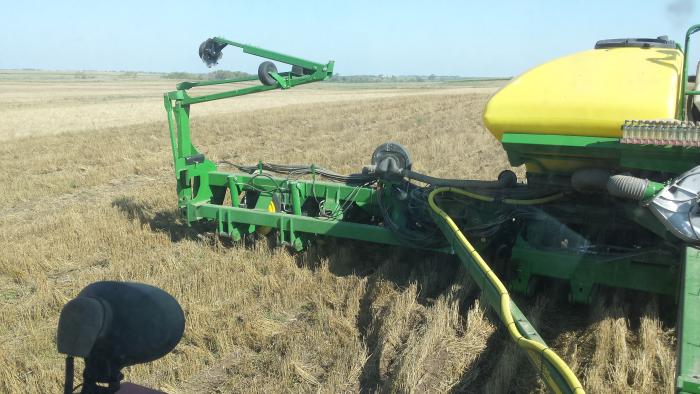Doing Good Work Together in Cavalier County
Cavalier County may have the coldest climate and shortest growing season in North Dakota.
Loretta Sorensen writes from Yankton, S.D.
In spite of that, Natural Resource Conservation Service (NRCS) District Conservationist, Brenyn Hardy says farmers there successfully manage the growing challenges.
“Greg Hornung’s operation consists primarily of small grains and a reasonable sized cattle herd,” Hardy says. “He has successfully transitioned from conventional tillage to no-till on the majority of his crop land. He’s also incorporated cover crops in his system.”

Hornung’s conservation journey began when he recognized that his soil organic matter was consistently decreasing.
“It was visible in the fields in the form of erosion and deteriorating soil health,” Hornung says. “That’s when a switch flipped, and I knew something had to be done.”
It’s been seven years since Hornung began implementing no-till in his fields and started learning how to manage the resulting crop residue. During the transition, he used a reduced/mulch till, managing the amount, orientation and distribution of crop residue while limiting soil-disturbing activities in growing and harvesting his crops.
“It took time to understand how to improve overall soil health in my light, sandy soils,” Hornung says. “With assistance through the NRCS Environmental Quality Incentive Program (EQIP), I gradually reduced tillage and improved my crop rotation. I trusted the benefits would begin to show.”
In 2015, with financial assistance through EQIP, Hornung started incorporating fall-seeded cover crops following harvest. This practice, in combination with no-till, crop rotation and residue management, helped Hornung build soil organic matter and reduce erosion.
“I’ve also found that using livestock to utilize my cover crops in ‘aftermath grazing’ helps me extend my grazing season and assist nutrient cycling,” Hornung says. “These conservation practices have been a win-win for all parts of my operation.”
Hornung is close to converting 100% of his fields to no-till and continues to integrate other conservation practices, such as cover crops, on an ongoing basis.
“I firmly believe he’s sold on the point behind using a suite of conservation practices,” Hardy says. “In years past, he had primarily two crops in his rotation. Today, he’s using all four crop types.”
Most recently, Hornung enrolled in the NRCS Conservation Stewardship Program (CSP) to expand his conservation practices further.
“Greg wants to address resource concerns such as nutrients in surface water, pesticides in surface water and volatilization of fertilizers,” Hardy says. “He’s implementing variable rate fertilizing, integrated pest management and using nitrification inhibitor and polymer coated fertilizers to address these concerns.”
Hardy points to Hornung’s conservation journey as a good example of the accomplishments farmers can realize when working through their local NRCS office.
“Greg is a great example of how available programs can help build a partnership between a producer and NRCS,” Hardy says. “Together we have addressed Greg’s concerns and put conservation practices to work.
“From a conservationist’s perspective, to see a farm go from conventional till with basic crop rotation and basic management into no-till, cover crops, livestock integration on cropland and advanced CSP enhancements has been special,” Hardy adds. “This is a good reminder of the work we can do together.”

